Sandymonium
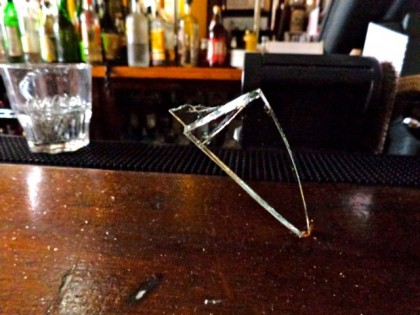 When artist John Willenbecher—whose name you might recall from the many “Where in Tribeca…?” photos he has contributed—showed me an essay written last November about Sandy and its aftermath, I begged him to let me run it. I find the memoir a delight from start to finish, and whether you spent Sandy and its aftermath here or elsewhere, I’m certain you’ll agree.
When artist John Willenbecher—whose name you might recall from the many “Where in Tribeca…?” photos he has contributed—showed me an essay written last November about Sandy and its aftermath, I begged him to let me run it. I find the memoir a delight from start to finish, and whether you spent Sandy and its aftermath here or elsewhere, I’m certain you’ll agree.
••••••••••••••••••••••••••
A little tap on the window-pane, as though something
had struck it, followed by a plentiful light falling sound,
as of grains of sand being sprinkled from a window
overhead, gradually spreading, intensifying, acquiring
a regular rhythm, becoming fluid, sonorous, musical,
immeasurable, universal: it was the rain.
—Marcel Proust, Du Côté de Chez Swann (translated by C. K. Scott Moncrief)
ON THE MONDAY AFTERNOON that Hurricane Sandy chose to come to town it was not quite like that. But the passage struck me as I began to read A La Recherche du Temps Perdu in the blackout days that followed her arrival. The book became a calming spirit in a time of anxiety—as well as a delight too long postponed; and at multiple thousands of pages a project seemingly endless at a time when normal activity was suspended for an unforeseeable future. In any case with no telephone, no Internet, no electricity—what else to do but read? So I moved a daybed close to my big arched window, the one that looks out on W. Broadway, and when I stretched out on it with Swann’s Way the late-afternoon light poured in on it over my shoulders. The finely-calibrated dimming of the page in front of me as I read and as the sun moved slowly behind the buildings to the west struck me Proustian in its refinement. This became a happy daily routine until electricity was restored.
But when it became too dark to read and the only way to continue meant the lighting numerous candles, I became restless and would go out for a walk in the dark. Some recreation, some bit of physical exertion seemed called for. And after all, it was by then only seven o’clock. Each night I pointed myself in a different direction.
THE HOURS OF SANDY’S MOST VIOLENCE RESIDENCE were horrific. Up until then everything had seemed pretty normal. On that Monday afternoon, in the studio, I took photographs of some recent paintings. Nothing particularly unusual about the weather outside. Some drizzle, a bit of wind. I put masking tape Xs on my windows in the living room area but ran out of tape before I could do the ones in the studio. It won’t be that bad.
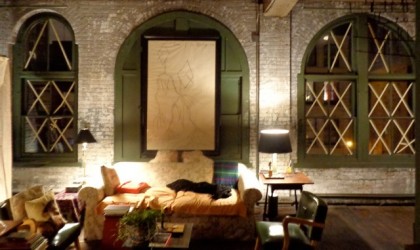 But by eight o’clock everything hand changed. Huge blocks of rain were being swept horizontally down W. Broadway, knocking over potted trees and carrying with them any available debris from the street, tearing down shop awnings and strewing them along the sidewalks. There was a wild raging of wind. Great sections of the seemingly ubiquitous protective wooden scaffolding that wraps the lower stories of so many New York buildings, including the hulking Art Deco Western Union pile on the opposite corner, were being ripped away by the force of the wind. Long wooden planks and 4′ x 8′ pieces of plywood and corrugated metal flew through the air and banged their way down the street. The crashing noise as they rammed into parked cars and smashed shop windows seemed unrelenting. Would my already rattly old 19th-century windows survive the howling wind? (Miraculously they did.)
But by eight o’clock everything hand changed. Huge blocks of rain were being swept horizontally down W. Broadway, knocking over potted trees and carrying with them any available debris from the street, tearing down shop awnings and strewing them along the sidewalks. There was a wild raging of wind. Great sections of the seemingly ubiquitous protective wooden scaffolding that wraps the lower stories of so many New York buildings, including the hulking Art Deco Western Union pile on the opposite corner, were being ripped away by the force of the wind. Long wooden planks and 4′ x 8′ pieces of plywood and corrugated metal flew through the air and banged their way down the street. The crashing noise as they rammed into parked cars and smashed shop windows seemed unrelenting. Would my already rattly old 19th-century windows survive the howling wind? (Miraculously they did.)
Mysteriously, during all of this both my telephone and Internet continued to work. Through my window I took some pictures of the scene of destruction taking place below and emailed them out. Rand, an artist friend who lives across the street, emailed back to say he had a broken window and he could see that one of the Odeon’s big plate-glass street windows had been smashed in. Upstairs, I had not heard it break in the ambient cacophony outside. Boards had been ripped from scaffolding in front of the little cast-iron building across the street—the one that Michael Imperioli until only recently owned and lived in—and lay scattered like giant pick-up sticks on the sidewalk in front of Edward’s restaurant. I emailed a shot of them to Robin Brouillette, a designer who had just taken (but not yet moved into), three floors in the building, including the ground-floor showroom. She emailed directly back to say she would come over right away.
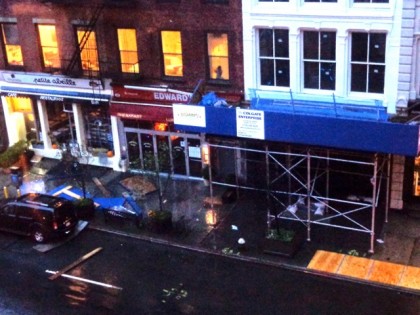 Shortly after all this, the lights dimmed ominously—and went out. Power completely off. Electricity, telephone land-line, cell-phone connection, Internet, all disappeared in an flash. By about nine the worst seemed to be over and the storm showed signs of abatement. Darkness. Silence. And so, as Samuel Pepys was fond of signing off in his Diaries, to bed. There really was nothing else to do. I took a sleeping pill, something I almost never do, and slept for ten hours.
Shortly after all this, the lights dimmed ominously—and went out. Power completely off. Electricity, telephone land-line, cell-phone connection, Internet, all disappeared in an flash. By about nine the worst seemed to be over and the storm showed signs of abatement. Darkness. Silence. And so, as Samuel Pepys was fond of signing off in his Diaries, to bed. There really was nothing else to do. I took a sleeping pill, something I almost never do, and slept for ten hours.
The next morning all was calm. Desultory rain, wisps of wind, the sun trying mostly in vain to peep through the low-lying clouds. The streets themselves were wet but not in any way flooded. From my window I could see shopkeepers already on hand to inspect the damage and a few neighbors congregating to compare notes. I decided to join them. Of course the elevator, requiring electricity to run, was not working, and as I walked down the mere three flights to the sidewalk I thought of those living the high-life nearby in apartment towers—bad enough for them and even worse if they happened to own dogs, the walking of which would now take on superhuman efforts. Downstairs, Lynn, the owner of the Odeon, and Steve, the manager, were conferring. I went inside the restaurant and photographed a thick shard of the broken plate glass window—a piece perhaps eight inches long—that had been hurled by the wind into the restaurant with such force that it remained embedded, point-down, in the top of the bar.
Two blocks away, Morgan’s Korean market was the only open store to be found. It was bizarre to see that place—which I have known so well since the days when its original owner, Earl Morgan, presided over the meat counter—lit up inside at mid-day by the bobbing flashlights of patrons plucking fast-disappearing stocks of canned goods, fresh vegetables, and fruit from the shelves. I had laid in a few things to nibble on yesterday—tuna salad, bread, fruit, hard-boiled eggs, some cold roast beef. At Morgan’s I bought the last three bananas. As it turned out I didn’t require much food because throughout the Sandy experience I had, for some reason, a rather noticeable lack of appetite. Just as well. Call it the Sandy Diet.
On my way home, going back up the steps, I schmoozed briefly and exchanged rumors—the lingua franca of Sandy—with my neighbors in the building. As for any similar rendezvous with friends in the neighborhood, that was out of the question since doorbells require electricity to work and pre-arranging a meeting by telephone was of course not possible. Throw stones at windows perhaps, as one did in the old pre-“Tribeca” days? Expect a front door key to be thrown down in a sock?
••••••••••••••••••••••••••
IT TAKES LONGER THAN ONE MIGHT THINK to kick the reflex of reaching to turn on a light and hearing only the clicking of its switch—or peering into shadowy gloom on opening the refrigerator door. And after a while it became clear that the worst of it all is not actually being lightless but not having any information. Just what has happened? How extensive is the blackout? Is it all of New York? What is being done to fix it? And when will I stop experiencing only a click when I turn on the light? For answers there were only rumors. One said that electrical power remained on only above 34th Street. Another that it had been turned off in lower Manhattan on purpose by Con Ed so that the utility might more easily repair any actual outage that might occur. Another claimed there had been a big explosion in a sub-station on 14th Street.
So I made a plan to gather up my laptop and get both of us uptown—walk if necessary but try to find a cab—and check in at the New York Public Library. Assuming, of course, that power was still on up there.
But on the next day, Wednesday, the plan was not carried out because a neighbor who lives on the floor above mine told me that in front of the apartment house at nearby at 50 Murray there were some portable power generators and that one could use them for cell-phone charging. Well, that would put me in touch with the outside world—and by the time I got to the generators two or three chargers were already stamping their feet to keep warm in the frosty weather while they waited for their batteries to drink in power. I managed to commandeer the last available socket.
When I walked back at mid-day, Edward, owner of the eponymous bar and eatery directly across the street, had set up long curbside tables stocked with comestibles from the restaurant—platters of grilled chicken, bread, cheese, salad, things that if not refrigerated would spoil. So free make-your-own sandwiches and plenty of bottles of water for all comers. Odeon contributed to the spread as well, but Lynn told me that they were going to transfer most of the restaurant’s perishables to her uptown place, Café Luxembourg. Robin was sitting on a sidewalk bench in front of her building having a cheese sandwich, so I introduced myself to her as the neighbor who had sent her the email photos on Monday evening.
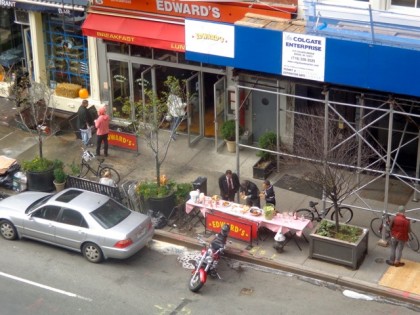 Yet more rumors: that electricity has been restored as far south as 23rd St. and that power will be restored to everyone in four or five days. Four or five days! That’s a lifetime, not “a few days.”
Yet more rumors: that electricity has been restored as far south as 23rd St. and that power will be restored to everyone in four or five days. Four or five days! That’s a lifetime, not “a few days.”
At home, suspecting a long haul setting in, I took it upon myself to tackle a job I have been putting off for many months: ridding myself of the hundreds of scraps of spare wood and other theoretically useful things that have been, over the years, collecting in and thoroughly clogging a corner of my studio. Clogging it to the point of embarrassment. Out! I sorted through it all and bundled up huge packages for disposal. It was mid-afternoon before I stopped. Of course the bundles would have to wait until power returned to our trusty (my fellow 145-ers will smile here) elevator.
I tried to make a call on my newly charged cell phone. No dice. “Out of range” it texted me back. And then I noticed as well that the battery I had charged only this morning was close to empty, doubtless due to the fact that I forgot to turn it off.
••••••••••••••••••••••••••
WHEN EVENING CAME ‘ROUND, après Proust, I went out on the first of my forays. I headed up W. Broadway thinking I would go so far as Houston. At Franklin, I peered down into the dark stairway that led, like a ominous Mouth of Hell, into the subway station below. Further along, the high black cliffs of the loft buildings lining W. Broadway were occasionally lit with dimly glowing, candlelit windows. No street lights, no traffic lights, just the moon making desultory appearances behind the clouds and casting startling shadows that would never have made it to the ground on an ordinary night. In the distance, almost invisible figures skirted flashlights in front of them as they walked. It was mirage-like, an eerie surrealist streetscape like something out of Delvaux—only without the bare-chested ladies. Of course the absurd quotidian always has a way of intruding on the poetic and in this case it was a local dog walker taking Mr. Pooch out for his constitutional. The electricity may have been off but the fascinating smells clearly remained.
At Houston and W. Broadway, I looked north and was taken aback to see that two of the three I. M. Pei New York University towers were ablaze with light. To have a better look I crossed Houston and went halfway up LaGuardia Place. There I found myself in front of a tiny mid-block bar that was, miraculously, open. It was lit by a single bright lightbulb and a lot of candles and it had a power generator chugging noisily away at the door. A man maybe in his thirties was standing by the curb smoking a cigarette and also looking at the NYU buildings. I asked him if he knew what was up with them. He seemed a very agreeable fellow and gave me his notion of why they had retained power. In doing so he happened to also mention that he was the owner of the establishment behind us. I asked him if there was any chance I could use his generator to charge my cell phone (which was luckily still in my pocket). “Of course!” he said and, putting his arm around my shoulder, led me into the bar. “Give this man a glass of wine,” he said to the bartender. “Red or white?” I plugged my phone into the outlet he indicated and walked over to the bar, no more than five or so seats long, and to the glass of red wine that was waiting. Turns out the place is called Le Souk and has a kind of faded, though sympatique, Moroccan decor. Standing on the bar were five alarmingly large hookahs, all fired up, which the others in the place occasionally toked from. One guy sitting a few stools away from me was arguing with Irving—by then I had learned the owner’s name—something about Franklin Roosevelt. He turned out to be the resident cook (when up and running, Le Souk is in fact a restaurant) and was squinting in the candlelight at a biography of FDR that rested on the bar next to his drink. The few others there appeared to be Souk regulars; one of them said she was a waitress. Everyone seemed to know everyone else and conviviality was the order of the evening. Another glass of red? Oh, sure, thanks! And, after a while, yet another… but not before Irving set out a row of shot glasses for us all and filled them with tequila. Cheers! Down the hatch! As I was unplugging my cell phone and preparing to leave, Irving said the batteries in his flashlight had gone dead and wondered if I by any chance had any to spare (I believe he thought I lived nearby). I said no but that I would be happy to give him the little LED flashlight I had with me.
Tottering home without it was not a problem. To have a different view I walked south along Wooster and sat for about 20 minutes on the Drawing Center’s raised porch drinking in the dreamy silence and the grisaille cityscape. A police car (it seemed like there were quite a few winding their way around the deserted streets) went slowly by but didn’t stop to wonder why someone might be just sitting there alone. Ah, New York!
THE NEXT MORNING I WAS DETERMINED to put my postponed uptown plan into action and by 10:15 a.m. I was off and walking briskly up Sixth Avenue. Well beyond Canal Street, I managed to hail a cab. I was a bit surprised when it pulled over, though, because the “not in service” sign was lit. “Where you goin’?” asked the cabbie through his lowered window. I told him Sixth and 38th and he said, “OK, get in.” Sitting on the other side of the back seat was a young woman with a briefcase, dressed for work. Off we went. I asked where she was going and she said as far as 59th Street. We made some polite conversation about Sandy. When we got to the curb at 38th Street the meter read $14 and I had already slipped my seatmate a $10 bill. The cabbie then looked back and, one arm over the seat, said to me “That’ll be ten dollars.” I mumbled something about one-ride-one-price and was out the door and walking down W. 38th Street before he could do anything about it. I hope my cabmate didn’t catch hell. On the other hand, she looked a sensible professional person and I’ll bet she didn’t cough up any more than her share.
Walking east towards Fifth Avenue, I began to notice that lights in shop windows seemed not to be on and stores that ought to be open were shut. Sandy?? Up here? Had I come all the way uptown for nothing? But the Mid-Manhattan Library, across the street from the marble lions, was lit up and there were people gathering about at the entrance. A hand-written sign on the door said “Open at 11.” It was now 10:45. A chart on the window said the library is normally opens at 8 a.m. Sandy, again?
When the doors opened I was among the first to go in and head directly up an escalator to a big room with tables and plenty of plugs for laptops. Two or more hours later, e-mails exchanged and cell phone and camera batteries charged, I was ready to leave. I walked to the 42nd Street branch of my savings bank—Emigrant. I like that branch it because it is a spacious throwback to the 50’s and also because it has big welded-metal wall sculptures by Klaus Ihlenfeld, an artist I met many years ago when he was working with Harry Bertoia in Pennsylvania. I wonder if Klaus is still at it. I took out some cash—all the banks downtown are, of course, closed—and continued to walk west on 43rd Street, presently arriving at Skidmore’s great Fifth Avenue Manufacturers Hanover Trust building, now painfully reconfigured to meet preservationist demands as a Joe Fresh store. Harry Bertoia’s expansive metal screen and hanging ‘birds nest’ sculpture have been re-installed after an out-of-town vacation but now the great, golden space divider serves as a backdrop for a long check-out counter and a group of gesticulating mannequins done up in fluorescent beach togs. What would Harry have thought? Knowing him, he would probably have smiled and shrugged a resigned OK.
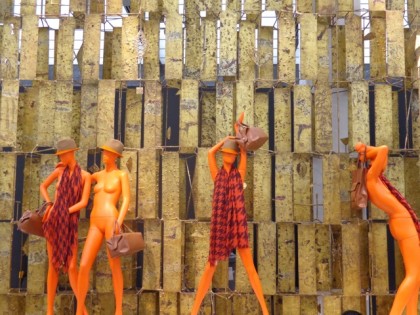 Still walking west and by the Century Club towards Times Square, I stopped at a smart-looking takeout place and got a pastrami sandwich to eat later. I also wanted to buy a New York Times—remember that?—and was astonished to realize that there are virtually no newsstands in Times Square. Only one, a cop I asked said, pointing two blocks away to the corner of Broadway and 42nd Street. I was thrilled to buy the next-to-last paper on the pile—but was disappointed when I got home to find out it was yesterday’s edition. Prankster Sandy?
Still walking west and by the Century Club towards Times Square, I stopped at a smart-looking takeout place and got a pastrami sandwich to eat later. I also wanted to buy a New York Times—remember that?—and was astonished to realize that there are virtually no newsstands in Times Square. Only one, a cop I asked said, pointing two blocks away to the corner of Broadway and 42nd Street. I was thrilled to buy the next-to-last paper on the pile—but was disappointed when I got home to find out it was yesterday’s edition. Prankster Sandy?
That evening my walk took me west on Chambers to Battery Park City. Its citizens, before Sandy hit, had been seriously advised to evacuate. What could it look like now? Imagine my astonishment to find that every building in the place was ablaze with light. I turned the corner at North End Avenue. A woman was standing in front of the entrance to what looked like a big apartment house. She appeared to be waiting for someone. I stopped and asked her how it was that Battery Park City had electricity when the rest of Lower Manhattan didn’t? She had no idea but added that they had had only a few hours of interrupted power at the very beginning. As I walked further along the side of the building I noticed a large window that gave into what appeared to be a comfortable library room with a large table strewn with copies of the New York Times. I retraced my steps and, at the entrance, noticed a plaque announcing the building as The Hallmark—an assisted-living retirement home. I strode confidently into the lobby, hung a left and soon found myself sitting at the newspaper-laden table. Heaven! No one paid me any attention. After all, I might easily be mistaken for a resident. On my way out I asked at the desk if they have wi-fi. I explained I live across the Great Divide (the West Side Highway) and have no power so might I come back tomorrow and tap in? “Yes of course, of course!”
Walking back home there was a bright spot at the corner of Greenwich and Chambers: a fruit and vegetable vendor, his stand brilliantly lit with battery powered lights. Strawberries! Bananas! Tomatoes!
The next day, Friday, I was back and having my living excellently assisted by the good people at The Hallmark. In the spacious, Georgian-esque living room I settled, laptop in hand, into a plush chair with a little table and a handy wall plug nearby. Hardly anyone else was in the room. I communicated with the outside world for a couple of hours, read today’s Times in the library, then typed a few more e-mails to friends. I felt thirsty so I asked one of the four lovely ladies at a nearby table playing Rummikub whether there was a “convenience center” where I could get a soda. She said, “Oh, dear, I think it is closed at this time. But,” pointing, “there is a shiva going on over there and I’m sure they could help you out.” Sure enough, down a short hallway there were two tables, one with cold drinks, one with coffee, framing a wide opening that looked into a room in which lots of people were eagerly partaking of an enormous spread of food on a big table in the middle. Well, say no more. Dinner was delicious. When I went back to my computer I smiled and gave a thumbs up to the lady who told me about the shiva. She said, “I hope you got something to eat, too.” I gave her and even more enthusiastic thumbs up and she said, “Good, because otherwise it will just go to waste.”
At home I settled in once again with the family at Combray but my reading was interrupted about 6 p.m. by a loud, jarring noise. It sounded like a shrill ringing. It was a ringing! It was my telephone! Carolyn, an artist and an old friend, was wondering how I was doing. I said, “Carolyn, you have no idea how happy I am to hear your voice!”
Early Saturday morning I awakened with a start. It was 4 o’clock. Both lamps on either side of my bed suddenly blazed on. Who knew that you could be awakened by sudden light?
I got up and wandered about the loft turning off lights. The welcome irony of that!
Copyright 2012 by John Willenbecher.







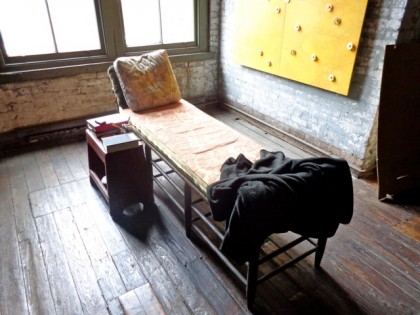
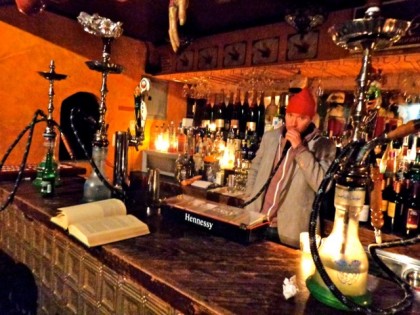






John, thanks for the full and memorable account — the walking especially. Boone and I at one point hiked north looking for bananas and didn’t find them till we hit 34th St. I wonder if by now you have reached Marcel’s experience of the sea’s reflection in the bookcase glass front. Proust, as you knew long before you set out to read him, is about much more than memory.
Dear John: Wonderful! You must publish this and make it available to a larger audience. Love, Naomi
John, this is so flavorful, so beautifully written, I wish you would write more about your life on West Broadway. It all started way back of course, and your account would be a remarkable history of the nabe. BTW, I remember talking with you when you were hunkered down at the NYPL! xo Anne
Amazing John….. great story!…..and that was the stormy start to our fabulous friendship!…. xx